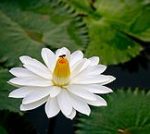 Also known as tiger lotus, Egyptian white water lily, and white lotus, this aquatic fresh water perennial is a member of the water lily family, Nymphaceae, a small family of 3-6 genera. It is native to east Africa and southeast Asia where it grows in clear, warm, still and slightly acidic waters. Growing 8-18″ tall from a rhizomatous root system it has large round leaves up to 12″ across that float on the surface of the water. The mature leaves are peltate, softly hairy below, and have spiny, toothed margins. The flowers appear all summer, are 5-10″ across, and consists of a center of golden stamens surrounded by conspicuously veined sepals and pointed petals that are white, sometime tinged with pink. They open at night, close by late morning, and are held up to 8″ above the surface of the water. Photo Credit Wikipedia
Also known as tiger lotus, Egyptian white water lily, and white lotus, this aquatic fresh water perennial is a member of the water lily family, Nymphaceae, a small family of 3-6 genera. It is native to east Africa and southeast Asia where it grows in clear, warm, still and slightly acidic waters. Growing 8-18″ tall from a rhizomatous root system it has large round leaves up to 12″ across that float on the surface of the water. The mature leaves are peltate, softly hairy below, and have spiny, toothed margins. The flowers appear all summer, are 5-10″ across, and consists of a center of golden stamens surrounded by conspicuously veined sepals and pointed petals that are white, sometime tinged with pink. They open at night, close by late morning, and are held up to 8″ above the surface of the water. Photo Credit Wikipedia
White Egyptian lotus served as models for the ornamention Egyptian tombs and temples and was also used for making perfume, funerary garlands, temple offerings, and as personal and garden adornments. It may have been the plant meant by the Hebrew word shushan but two other alternatives are possible: Nymphae caeruleae (blue loytus) and Nymphaea alba (white water lily).
I Kings 7 ( NIV) The furnishings of Solomon’s temple are described.
19. “The capitals on top of the pillars in the portico were in the shape of lilies, four cubits high.”
22. “The capitals on top were in the shape of lilies. And so the work on the pillars was completed.”
26. “It was a handbreadth in thickness, and its rim was like the rim of a cup, like a lily blossom. It held two thousand baths.”
II Chronicles 4:5 (NIV) The huge washing basin in Solomon’s temple is described.
“It was a handbreadth in thickness, and its rim was like the rim of a cup, like a lily blossom. It held three thousand baths.”
The white Egyptian lotus likes full sun, undisturbed fresh water, and slightly acidic soil in Zones 10-12. Site so the plants are protected from the wind and fertilize with aqautic fertilizer every 2-3 weeks. Plants may suffer damage from aphids, midges, China mark moth, and crown root. Propagation is by seed and division of the rhizomes. Plants have medicinal properties and all parts of the plant are edible. It may have been the lotus mentioned in Homer’s Odysseys. The plant can become invasive in the rice fields of modern Egypt.
The genus name, Nymphaea, comes from the Greek word numphaios and means sacred to the nymphs. The specific epithet, lotus, is from the Greek word lōtos, used to denote certain plants.